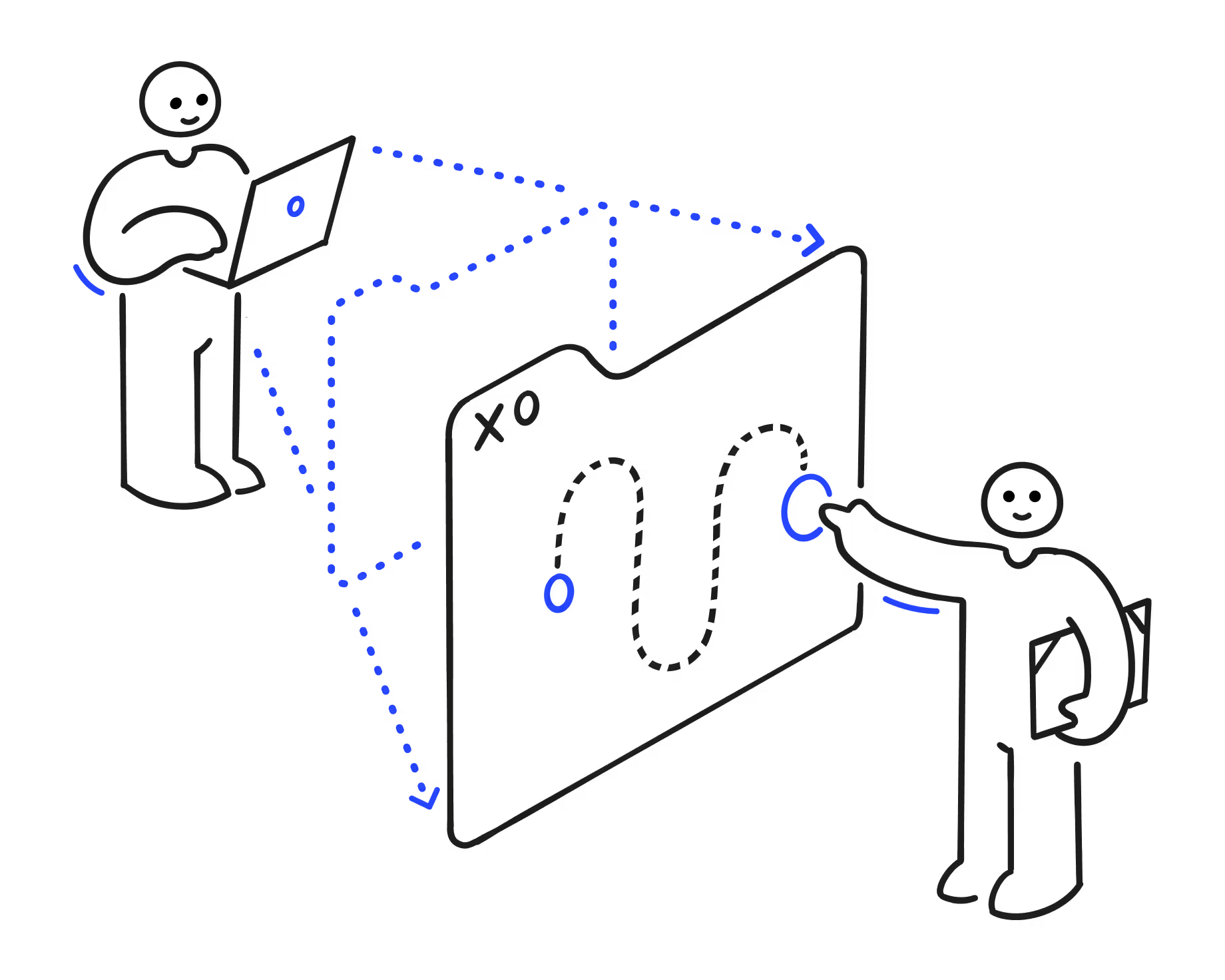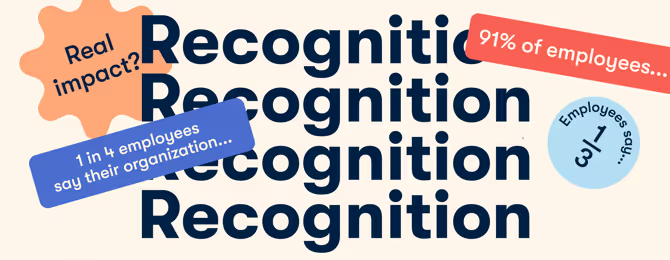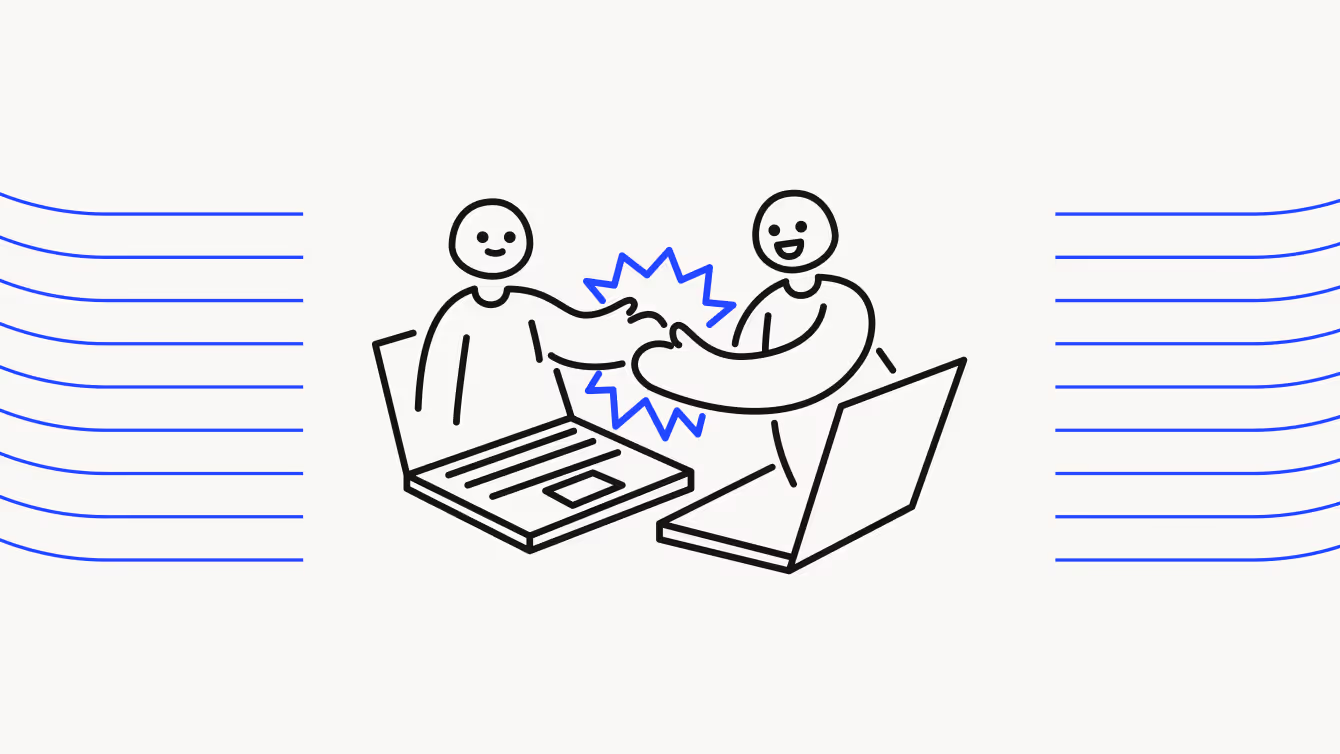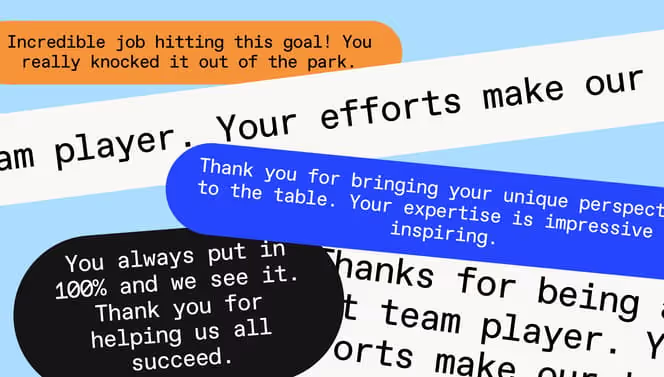Recognition in the workplace: 6 ways to champion employees

Discover Workleap Officevibe's benchmark report on 12 key employee engagement metrics

Recognition in the workplace goes a long way. Shouting out employee accomplishments helps them feel motivated to deliver results and go above and beyond. It’s one of the strongest drivers of engagement, retention, satisfaction, and high productivity.
Without genuine employee recognition, morale drops and turnover rises. Workers need to have their efforts noticed, whether through peer-to-peer praise, milestone celebrations, or a formal employee recognition program.
In this guide, we explore the benefits of employee recognition and offer six practical strategies to acknowledge your team.
What is job recognition?
Job recognition, also called employee recognition, is when you show appreciation for an employee's contributions. It can take many forms, including verbal praise or a dinner to celebrate milestone events.
More than just the right thing to do, employee recognition is a sound business strategy: According to Gallup-Workhuman, well-recognized employees are 45% less likely to leave. Creating moments of acknowledgment motivates your team and reminds them that their efforts really do impact the overall organization.
Why employee recognition is important
Recognition in the workplace is one of the simplest ways to drive employee happiness and business success. Here are seven benefits of employee recognition:
- Boosts retention: Employees who feel appreciated are more likely to stay in their roles, avoiding costly workplace turnover.
- Fosters teamwork: Employee appreciation helps build relationships between colleagues, resulting in a team that works together better.
- Enhances engagement: Consistent recognition in the workplace is proven to boost energy, focus, and engagement.
- Creates a culture of recognition: Making praise and appreciation part of your organization’s day-to-day improves morale and helps shape a positive employee experience.
- Strengthens company values: When you recognize employees for contributing to your company's values, you reinforce what matters most.
- Builds employer branding: A culture of recognition gives you a competitive advantage by attracting top talent and boosting your company’s reputation.
- Motivates employees: Personalized recognition inspires employees to grow and achieve more, resulting in better-quality work.
Ways of recognizing employees: 6 best practices
Recognition in the workplace works best when it’s fast, frequent, and specific. Here’s how to do it.
1. Set a clear vision
An effective employee recognition program starts with goal-setting. Recognition without purpose falls flat, so define what success looks like and connect it to company values. When you shout out accomplishments that support these goals, you strengthen workplace culture.
2. Offer consistent recognition
Don’t wait for performance reviews to celebrate wins. Offer praise right after an employee’s achievement so they see that hard work is appreciated. A regular cadence, like weekly shout-outs, keeps employee engagement and morale high.
3. Use simple, accessible recognition methods
You can’t automate empathy, but you can make your employee recognition program easy to use. Make it simple to recognize employees in straightforward ways, from quick appreciation messages to small, meaningful rewards. Use accessible methods so managers and team members can all participate.
4. Use specific criteria, but be flexible
Transparency builds trust in the workplace. Define measurable criteria for accomplishments, contributions, and milestones so everyone knows how to earn recognition. But stay flexible so you can still capture standout efforts that don’t fit one of those metrics.
5. Be inclusive and equitable
A strong workplace culture encourages recognition more than top-down mandates ever will. Encourage shout-outs, celebrate diversity contributions, and acknowledge people equally across teams. When employee recognition reflects your company values and workplace culture, it helps everyone feel like they belong.
6. Measure success and gather feedback
Track the results of your employee recognition program and measure how recognition impacts employee engagement, retention, and morale. Be sure to encourage workers to share insights and feedback frequently to determine whether the program works and how to strengthen it.
Workleap Officevibe makes building a culture of recognition simple. The platform improves workplace communication through pulse surveys, anonymous feedback tools, and Good Vibes recognition. Celebrate team wins in real time and align recognition with your company’s values.
What are the types of recognition at work?
Not all recognition is created equal. Understanding the different types can help you choose the best methods for your team. Here are a few of the most common.
Formal recognition
Formal recognition is a structured, documented acknowledgment that follows an established program or process. Examples include sharing a Good Vibes card, highlighting someone’s achievements in a performance review, running an employee-of-the-month program, or dedicating a recognition segment in a town hall.
Informal recognition
Informal recognition is often unplanned and tends to happen naturally as people work together and collaborate. They’re usually spontaneous forms of recognition, such as a quick Slack message or a shout-out in a meeting. Meaningful gestures like these can help managers build trust and stronger relationships with their direct reports.
Peer-to-peer recognition
You can create a culture where people take responsibility for appreciating each other instead of always coming from up high. Peer-to-peer recognition, also called social recognition, encourages team members to celebrate each other’s contributions. Whether a shout-out in a group chat or a mention during a team meeting, it promotes engagement and builds strong connections between colleagues.
Monetary recognition
Tangible rewards can have a huge impact. Monetary recognition includes bonuses, vouchers, gift cards, and other financial rewards for hard work. While it’s certainly not the only way to motivate employees, it’s a powerful tool for showing appreciation.
Top-down recognition
Top-down recognition is when leadership acknowledges its employees. A manager or executive might recognize outstanding accomplishments during a status update or all-hands meeting. This approach reinforces the company’s values and aligns recognition with business priorities.
Direct-report recognition
This type of recognition is when a manager gives one-on-one appreciation to their employee. Offering private, specific feedback builds trust and helps people feel genuinely appreciated. When managers make direct-report recognition part of their regular check-ins, it keeps employee engagement and motivation high.
Day-to-day recognition
Day-to-day recognition is all about celebrating your employees’ smaller wins. This could be thanking your team for hosting a presentation or shouting out someone’s accomplishments in a group chat. These small gestures don’t feel small to the person receiving them.
Above and beyond recognition
When your employees truly go the extra mile, above-and-beyond recognition highlights their hard work. This might be from them taking the initiative on a complicated project or helping colleagues in a bind. Recognizing these moments motivates employees to contribute their best work.
Career recognition
Career recognition honors a team member’s milestones, like five years at the company or closing 100 deals. Acknowledging these achievements builds loyalty and motivates employees to strive towards their next goal.
Hosting events
Team celebration events turn employee recognition into a shared experience. This might mean hosting a team lunch or a company-wide award ceremony. Group events foster community, appreciation, and a stronger workplace culture.
3 employee recognition deployment methods
Here are a few ways employee recognition can be deployed in the workplace.
1. Helping managers celebrate employees
One of the easiest ways to boost employee recognition is to make it simple for managers to celebrate wins. Provide team leaders with a calendar filled with reminders of anniversaries, birthdays, and creative recognition ideas.
2. Making recognition visible
Recognition is more powerful when it’s visible to all. Set up systems that flag exceptional contributions, allowing managers and peers to celebrate success as it happens. You can also publicly recognize employees in newsletters, team channels, and company updates.
3. Meaningful personal gestures
Sometimes, the most impactful employee recognition comes from simple, thoughtful actions. A handwritten note, a shout-out during a milestone celebration, or a small gift are all great options. They remind your team that you see and appreciate what they’re doing. When you offer genuine recognition, it shows up in their work.
Recognize your employees with Workleap Officevibe
Employee recognition fuels engagement, boosts performance, and strengthens workplace culture. Even small gestures make a world of difference. Timely, personal, and consistent recognition helps employees feel genuinely valued, which has a lasting business impact.
Workleap Officevibe makes creating this type of culture easy. Use pulse surveys to gather feedback, anonymous channels to encourage openness, and team insights to track engagement trends. You can also support employees with one-on-one meeting tools and celebrate wins with Good Vibes’ public praise wall and private recognition cards.
The bottom line? Making recognition part of your day-to-day helps everyone feel connected and satisfied, leading to happier employees and better work.
Try Workleap Officevibe for free today to start building a culture of recognition your people will love.
Give HR and managers the clarity, confidence, and connection to lead better every day.


%20(1).avif)


.avif)
.avif)







